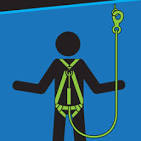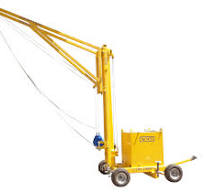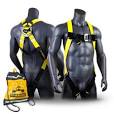The Importance of Using a Personal Fall Arrest System
When working at heights, safety should always be the top priority. One crucial piece of equipment that can prevent serious injuries or fatalities in the event of a fall is a Personal Fall Arrest System (PFAS). A PFAS is designed to protect workers from falls by stopping them mid-air and reducing the impact of the fall.
Components of a Personal Fall Arrest System
A typical PFAS consists of several components that work together to ensure maximum safety:
- Full Body Harness: The harness distributes the impact forces throughout the body, reducing the risk of injury.
- Lanyard or Lifeline: This connects the harness to an anchor point and allows for movement while providing protection in case of a fall.
- Anchor Point: A secure point of attachment that can support the weight of the worker in case of a fall.
- Deceleration Device: Slows down the fall and reduces impact forces on the body.
The Benefits of Using a PFAS
Using a Personal Fall Arrest System offers numerous benefits, including:
- Fall Protection: Provides a reliable means of protection in case of accidental falls.
- Compliance with Regulations: Helps companies comply with safety regulations and standards set by OSHA and other regulatory bodies.
- Piece of Mind: Workers can focus on their tasks knowing that they are protected in case of a fall.
Tips for Proper Use
To ensure maximum effectiveness and safety when using a PFAS, consider these tips:
- Proper Training: Ensure all workers are trained on how to properly inspect, wear, and use the equipment.
- Regular Inspections: Conduct regular inspections to check for wear and tear on all components of the system.
- Frequent Replacements: Replace any damaged or worn-out components immediately to maintain optimal safety levels.
In conclusion, investing in and properly using a Personal Fall Arrest System is essential for anyone working at heights. By following proper procedures and guidelines, workers can significantly reduce the risks associated with falls and ensure their safety on the job site.
9 Key Benefits of a Personal Fall Arrest System for Workplace Safety
- Provides fall protection for workers at heights
- Reduces the risk of serious injuries or fatalities in case of a fall
- Complies with safety regulations and standards set by OSHA
- Offers peace of mind to workers knowing they are protected
- Allows for safe movement while working at elevated levels
- Distributes impact forces throughout the body, minimizing injury risks
- Can be customized to fit individual needs and job requirements
- Easy to inspect and maintain for optimal performance
- Enhances overall safety culture in the workplace
Challenges of Using a Personal Fall Arrest System: Movement Restriction, Bulkiness, Training Needs, and Cost
Provides fall protection for workers at heights
One significant advantage of a Personal Fall Arrest System is its ability to provide essential fall protection for workers operating at elevated heights. By equipping workers with a PFAS, companies can ensure that their employees have a reliable safety measure in place in case of accidental falls. This proactive approach not only safeguards the well-being of workers but also promotes a secure work environment where individuals can perform their tasks with confidence and peace of mind.
Reduces the risk of serious injuries or fatalities in case of a fall
One significant advantage of a Personal Fall Arrest System is its ability to reduce the risk of serious injuries or fatalities in the event of a fall. By swiftly stopping a fall and mitigating the impact on the body, a properly utilized PFAS provides crucial protection for workers at height. This proactive safety measure not only safeguards individuals from harm but also instills confidence and peace of mind, ensuring a safer work environment overall.
Complies with safety regulations and standards set by OSHA
One significant advantage of using a Personal Fall Arrest System is that it ensures compliance with safety regulations and standards established by OSHA (Occupational Safety and Health Administration). By utilizing a PFAS, companies can demonstrate their commitment to prioritizing the safety and well-being of their workers while adhering to the strict guidelines set forth by regulatory bodies. This proactive approach not only helps in creating a safer work environment but also mitigates the risk of potential fines or penalties for non-compliance with OSHA regulations.
Offers peace of mind to workers knowing they are protected
One significant advantage of a Personal Fall Arrest System is that it provides peace of mind to workers, assuring them that they are protected in the event of a fall. Knowing that they have a reliable safety system in place allows workers to focus on their tasks without constant worry about potential hazards. This sense of security not only boosts morale but also enhances productivity as employees can work confidently and safely at elevated heights.
Allows for safe movement while working at elevated levels
One significant advantage of a Personal Fall Arrest System is that it allows for safe movement while working at elevated levels. By providing a secure connection between the worker and an anchor point, the system enables individuals to perform their tasks with confidence and freedom of movement. This feature not only enhances productivity but also ensures that workers can navigate their work environment safely without compromising their safety in the event of a fall.
Distributes impact forces throughout the body, minimizing injury risks
One significant advantage of a Personal Fall Arrest System is its ability to distribute impact forces throughout the body, thereby minimizing the risks of injuries. By spreading the force of a fall across the entire body through the full-body harness, the system helps reduce the strain on any single point of contact. This feature plays a crucial role in protecting workers from severe injuries during falls by ensuring that no specific body part bears the brunt of the impact, ultimately enhancing safety and mitigating potential harm in hazardous situations.
Can be customized to fit individual needs and job requirements
One significant advantage of a Personal Fall Arrest System is its ability to be customized to fit individual needs and job requirements. This flexibility allows workers to tailor the system to their specific tasks, ensuring optimal comfort, functionality, and safety. By adjusting components such as harness size, lanyard length, and anchor points, individuals can create a personalized fall protection solution that meets the demands of their work environment. Customization not only enhances user satisfaction but also promotes greater compliance with safety regulations and standards, ultimately contributing to a safer work environment for all involved.
Easy to inspect and maintain for optimal performance
One significant advantage of a Personal Fall Arrest System is its ease of inspection and maintenance for optimal performance. Regularly inspecting the components of the system allows for early detection of any wear or damage, ensuring that the equipment is in proper working condition. By conducting routine maintenance and promptly addressing any issues, users can maximize the effectiveness and reliability of the system, providing peace of mind and enhanced safety while working at heights.
Enhances overall safety culture in the workplace
Implementing a Personal Fall Arrest System in the workplace enhances the overall safety culture by prioritizing the well-being of employees and emphasizing the importance of safety measures. By providing workers with reliable fall protection equipment, employers demonstrate their commitment to creating a safe work environment and fostering a culture of safety awareness. This proactive approach not only reduces the risk of accidents and injuries but also promotes a sense of trust and confidence among employees, ultimately leading to a more secure and productive workplace.
Restriction of Movement
The restriction of movement is a significant con associated with using a Personal Fall Arrest System. Workers may find their freedom of movement limited, particularly when working at heights or in confined spaces. This limitation can impede productivity and efficiency, making certain tasks more challenging to perform. Additionally, restricted movement may cause discomfort or fatigue for workers who need to navigate carefully while wearing the harness and being connected to the anchor point. It is essential for employers to consider these limitations and provide appropriate training to ensure that workers can safely and effectively perform their duties while using a Personal Fall Arrest System.
Weight and Bulkiness
One significant drawback of a Personal Fall Arrest System is the weight and bulkiness of certain components, such as the harness and lanyard. The added heft and size of these elements can lead to discomfort and restrict movement, potentially hindering the worker’s efficiency and agility while on the job. Workers may find it challenging to maneuver or perform tasks comfortably with these bulky components, making it crucial to strike a balance between safety and practicality when selecting and using a personal fall arrest system.
Training Requirements
One significant con of a Personal Fall Arrest System is the training requirements involved. Proper training is crucial for using a PFAS effectively, as it ensures that workers understand how to inspect, wear, and use the equipment correctly. This training may necessitate additional time and resources to ensure that all workers are adequately trained, which can be a logistical challenge for employers. Failure to provide comprehensive training could lead to improper use of the system and increase the risk of accidents or injuries when working at heights.
Cost
The cost associated with investing in quality Personal Fall Arrest Systems can be a significant con, particularly for companies with multiple employees who need these safety measures. The expenses involved in purchasing and maintaining the equipment, providing proper training, and ensuring regulatory compliance can add up quickly, putting a strain on the company’s budget. This financial burden may deter some organizations from prioritizing worker safety or investing in the necessary equipment, potentially putting employees at risk of serious injuries in the event of a fall.




